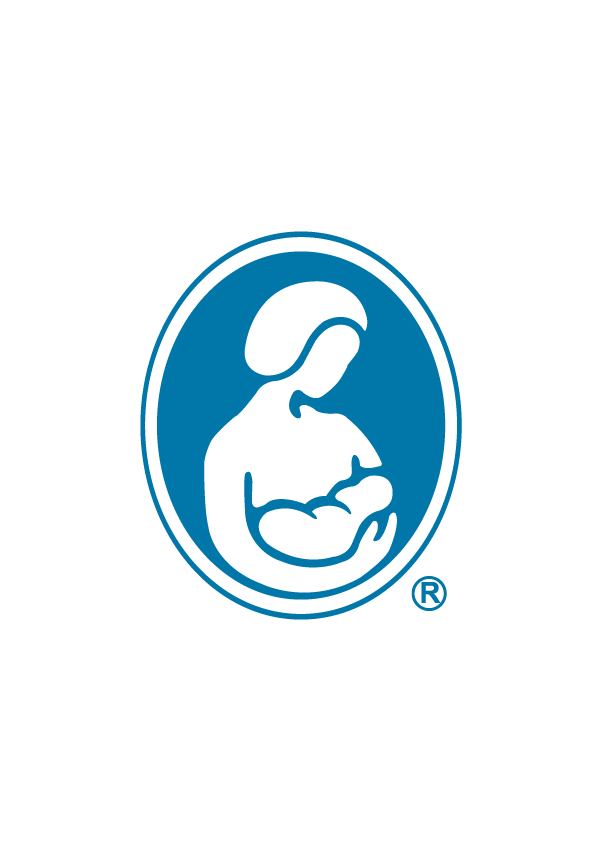点击上方 国际母乳会LLL 设为星标 ,获取哺乳信息
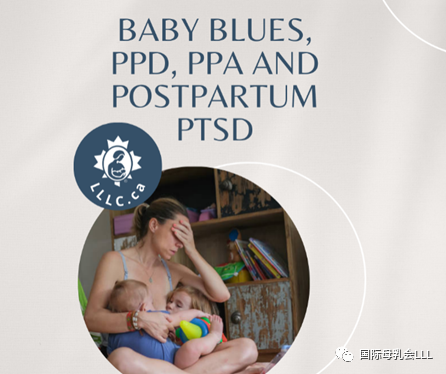
图|国际母乳会中国图片库
像许多母亲或新手父母一样,您可能有照顾自己的新生宝宝完全不知所措的经历。
产后沮丧
您可能发现自己感到悲伤或想哭。这通常从产后第3~5天您的乳汁供应量增加(即“下奶”)时开始。
这种悲伤的感觉可能会在几个小时或几天内一波又一波地反复。我们称之为“产后沮丧”。它会随着母乳喂养的建立以及体内孕产相关的激素水平下降而得到改善。这种症状通常持续一到两周。大约50%至80%的母亲会经历这种“产后沮丧”。
如果您母乳喂养有困难,或者您认为宝宝可能母乳没有吃够,就会感到很有压力。如果有这种感觉,您可向医疗保健专业人员和您所爱之人寻求所需的支持。在产后初期,对自己和宝宝要有耐心。在国际母乳会聚会中与其他新手妈妈交流,会让您知道自己并不孤单。
相关信息:
伴侣和支持者如何提供帮助HOW PARTNERS AND SUPPORTERS CAN HELP
如何知道婴儿是否吃到了足够的母乳 How to Know Your Baby is Getting Enough Milk
产后抑郁症(PPD)
感觉她们在育儿方面做得不好 为生了孩子而感到内疚 为她们再也感受不到幸福而绝望 在集中注意力和做决定的方面有困难 饮食和睡眠模式被打乱(超出了家里有小宝宝的正常范围) 被孤立,因为她们没有精力走出家门或与其他人互动
以前诊断出患有抑郁症或其它精神疾病 有虐待史 高水平的全身性炎症,例如感染或严重创伤、烧伤或出血 分娩或哺乳引起的疼痛 母亲认为她的分娩经历很负面(这不同于实际上确实有负面的分娩结果) 婴儿“高需求”或有“很难搞定”的气质 缺乏社会支持
产后焦虑症(PPA)
产后强迫症(PPOCD)
担心宝宝会意外或故意受伤 担心宝宝会生大病 担心宝宝会因环境中的食物或化学物质中毒 害怕独自陪伴婴儿 害怕做出对婴儿有负面影响的决定
产后创伤后应激障碍(PTSD)
分娩期间经历的创伤可能导致产后创伤后应激障碍。
值得注意的是,即使很多人认为生产 “很成功”,母亲(或父母)仍然会觉得是创伤。产后创伤后应激障碍会增加患产后抑郁症的风险。
创伤性事件可能包括:
分娩时非常担心自己或宝宝的健康
极度疼痛。分娩期间有并发症。觉得医务人员不支持自己。感觉对自己的身体或分娩无法控制。
在分娩期间感到不受尊重、被辱骂、被羞辱或被虐待。
产后创伤后应激障碍的症状包括:
重新经历分娩时的创伤事件
梦魇和回想重现
回避与分娩相关的人员、地方或情况(例如:回避医院)
睡眠困难
疏离感(例如:感觉与宝宝疏远)
频繁不断地哭泣
食欲改变
感到绝望
对曾经喜欢的事情失去兴趣

一位母亲记得她在儿子过一岁生日时,感觉松了很大口气——儿子终于活下来了,尽管她(自认为)育儿方式“很笨拙”。
回过头来,她意识到从那天起,生活感觉更容易了,快乐又回归了。不论是她还是身边的人,都没有意识到她在第一年中经历着产后抑郁症,因为她看起来是正常的。
治疗
这些心理健康状况的治疗通常集中在三个主要策略上:
药物
获得充足、优质的睡眠
获得家庭/社区的支持
与医护人员合作找出适合您和家人的策略是非常重要的。理想情况下,此策略要包含以上这三个方面。睡眠不足是使症状加重的最大因素之一。如果您正在母乳喂养同时还与睡眠不足作斗争,请向您的支持网络寻求帮助。您在维持奶量以及母乳喂养宝宝的同时,要找到哪些方法能让您睡得更好。
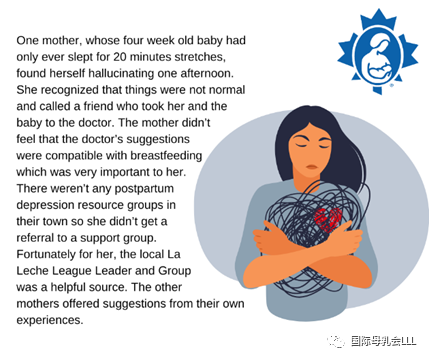
一位母亲,她四周大的宝宝每次睡觉仅能睡20分钟,一天下午她发现自己产生了幻觉。她意识到情况很不寻常,就叫朋友带她和孩子去看了医生。这位母亲觉得医生的建议和母乳喂养不相容,而这对她来说非常重要。她所在的镇子上也没有任何产后抑郁症的支持团体可推荐给她参加。幸运的是,当地的国际母乳会哺乳辅导和小组是很好的资源。母乳会小组中的其他母亲从自身经历中给她提供了建议。
许多人认为,用药物来治疗心理健康状况是不建议母乳喂养。这种想法会使一些母亲不太愿意考虑将药物作为治疗选择。如果您想继续母乳喂养,请告知医疗保健专业人员您需要与母乳喂养兼容的药物。如果建议的药物与母乳喂养不相容,您可以询问是否还有其它选择。
其它的治疗包括:
增加长链脂肪酸(omega3)的摄入
做运动
SAMe(S-腺苷-L-蛋氨酸),这是一种天然存在于体内的化合物,其合成物可作为膳食补充剂。
认知行为疗法(小组或个人)
上述的大多数治疗方法都可以减轻体内的炎症。新罕布什尔州母乳喂养工作组的文件《患抑郁症的新手妈妈母乳喂养的好方法》(http://www.uppitysciencechick.com/ppd_curric_final_2009.pdf),对于想要查看治疗产后抑郁症的所有方案(包括药物治疗)的父母和专业人士来说是一个很好的资源。
更多的相关资源,请参阅产后抑郁症资源网页:http://www.uppitysciencechick.com/postpartum-depression.html
成功的母乳喂养是可以预防患这些疾病的。它也是一种有用的应对策略。把更好的衔乳技巧与学习如何躺着哺乳结合起来,有助于克服困难。
一些女性发现停止母乳喂养可以改善她们的抑郁症,而另一些人则发现这会加重她们的抑郁症状。是否母乳喂养,完全有您来决定。
如果您怀疑您或您所爱的人患有产后抑郁症、产后焦虑症或产后创伤后应激障碍,联系医疗保健专业人员非常重要。国际母乳会的哺乳辅导可以提供有用的支持和信息
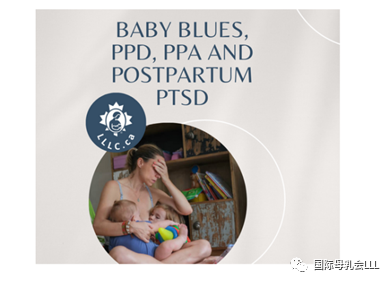
Baby Blues, PPD, PPA, PPOCD, and Postpartum PTSD
Like many mothers or new parents, you may have the experience of being completely overwhelmed caring for your new baby.
“Baby Blues”
You may find yourself feeling sad and weepy. This often starts on the day your milk supply increases (‘comes in’) between days three and five. This feeling of sadness may come and go in waves over a few hours or days. We call this the “baby blues”. It improves as breastfeeding is established and as the pregnancy and birthing hormones leave your body. This is usually within one to two weeks.
About 50 to 80% of mothers experience the “baby blues”. It can be very stressful if you are having difficulty breastfeeding or if you think your baby may not be getting enough. It helps to get the support you need from healthcare professionals and those you love. Be patient with yourself and your baby in these early days. Talking with other new mothers at La Leche League meetings lets you know you’re not alone.
Additional related information:
How Partners and Supporters Can Help
Positioning and Latching
How to Know Your Baby is Getting Enough Milk
Establishing Your Milk Supply
Postpartum Depression (PPD)
Unlike the baby blues, postpartum depression (PPD) symptoms don’t fade away after a few weeks. They can start any time during the first year after birth. About 13% to 20% of mothers and 2% to 25% of fathers experience PPD. If the underlying causes aren’t dealt with, the symptoms may continue to get worse over time. Mothers experiencing PPD report:
feeling that they are not doing a good job of parenting.
feeling guilty for having had a child.
despairing that they will never feel happy again.
having difficulty concentrating and making decisions.
having disrupted appetite and sleep patterns (beyond what is normal with a young baby in the house).
being isolated because they don’t have the energy to get out of the house or to interact with other people.
Very occasionally (less than 1%) mothers with PPD have thoughts of hurting themselves or their baby. Immediate mental health help is needed in these cases. Often hospitalization and medication is required to stabilize their symptoms and to keep themselves and their babies safe.
Some of the predictors of postpartum depression are:
previously diagnosed depression or other mental illness.
history of abuse.
high levels of systemic inflammation, for example from an infection or from severe trauma, burns or bleeding.
pain from childbirth or breastfeeding.
the mother’s perception that she had a negative birth experience. This is different from having an actual negative outcome of the birth.
having a baby with a “high needs” or “intense” temperament.
lack of social support.
Physical and psychological stressors increase inflammation. Recent research suggests that inflammation may be a risk factor for depression. Current treatments for PPD include reducing maternal stress and decreasing inflammation. Breastfeeding and exercise help reduce maternal stress. Medications may be needed to reduce inflammation.
The Edinburgh Postnatal Depression Scale (https://psychology-tools.com/epds/) is a self-screening tool that you can use to identify whether or not you are depressed. Perinatal Services BC http://www.perinatalservicesbc.ca/health-professionals/professional-resources/public-health/edinburgh-postnatal-depression-scale-(epds)has printable copies in English and several other languages.
If you are experiencing relatively mild postpartum depression, you may not recognize what is happening to you. Our society expects new parents to be happy to have their babies. It can be hard to talk about your feelings if you do not feel safe speaking about them. You may be afraid of being judged for not being thrilled about life with a baby.
Postpartum Anxiety (PPA)
Some new parents experience constant worry or fear after having their babies. They may have difficulty sleeping, experience fatigue (beyond what is to be expected with a newborn) and have other symptoms of anxiety. This is called Postpartum Anxiety (PPA). Symptoms of PPA are often similar to symptoms of PPD. Parents may have both conditions. About 6% to 28% of women may experience PPA during the first six months after giving birth. Women are twice as likely to experience PPA than men.
Postpartum Obsessive Compulsive Disorder (PPOCD)
Between 3 to 5% of new parents may experience a type of postpartum anxiety called Postpartum Obsessive Compulsive Disorder (PPOCD). Parents with PPOCD experience persistent, repetitive, frightening thoughts they cannot control. These obsessive thoughts are about perceived dangers to the baby. Parents are very unlikely to act upon these thoughts.
Instead they are often hypervigilant (overly careful) and compulsive about protecting the baby from these perceived dangers. Many new parents do not report these feelings due to fears that the baby will be removed from their care. Untreated PPOCD can lead to difficulty bonding with and caring for the baby. Obsessive thoughts and compulsions can also impact a mother by affecting her ability to sleep or care for herself.
Common obsessive symptoms of PPOCD are:
worries that the baby will be injured accidentally or intentionally.
worries that the baby will develop a serious illness.
worries that the baby will be poisoned by food or chemicals in the environment.
fears of being left alone with the baby.
fears of making decisions that will negatively affect the baby.
Common compulsive behaviours of PPOCD are:
removing sharp objects such as knives and scissors from the home.
obsessively checking on the baby when she sleeps.
constantly cleaning.
asking others for reassurance that the baby has not been harmed or abused.
avoiding certain behaviours because of fears of harming the baby such as bathing, feeding or holding the baby.
These symptoms usually appear around 2 to 3 weeks postpartum. They often come on gradually and get worse over time.
Postpartum Post-Traumatic Stress Disorder (PTSD)
Trauma experienced during childbirth may lead to postpartum PTSD. It is important to note that even a birth that many see as “successful” can still be experienced as traumatic by the mother or parent. Postpartum PTSD can increase the risk of developing PPD. Traumatic events can include:
feeling very worried about your health or your baby’s health during birth.
extreme pain. complications during childbirth. feeling unsupported by staff. feeling like you have no control over your body or birth.
feeling disrespected, abused, humiliated, or mistreated during childbirth.
Symptoms of Postpartum PTSD include:
Re-living or re-experiencing traumatic aspects of the birth
Nightmares and flashbacks
Avoidance of people, places or situations related to the birth (for example: avoidance of hospitals)
Sleep difficulties
Feelings of detachment (for example: feeling distant from your baby)
Episodes of frequent crying
Changes in appetite
Feeling hopeless
Loss of interest in things you used to enjoy
Getting Help
If you have any of these mental health conditions it can also be confusing for those around you. Partners may be unsure of how to help. They don’t understand that you can’t just “snap out of it and cope like other new mothers.” Older children may feel uncertain about the changes in your behaviour. You may struggle to respond to your newborn. Breastfeeding can help you maintain the relationship with your baby. If you are chronically depressed or anxious, your newborn may be negatively affected. Thus, getting treatment is important. When symptoms are severe, it is often those around you (partners, relatives and friends) who put together the clues. They may be the ones to suggest that you get a proper diagnosis and support.
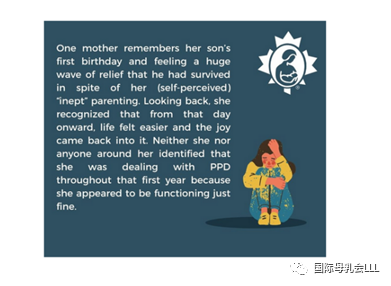
Treatment
The treatment of these mental health conditions generally focuses around three major strategies:
·medication,
·getting enough good quality sleep,
·and family/community support.
It is important to work with your healthcare provider to find a strategy that works for you and your family. Ideally, this strategy will include all three of these approaches.
Lack of sleep is one of the biggest factors in making symptoms worse. If you are breastfeeding and struggling with sleep deprivation, ask for help from your support network. You’ll want to find ways to get more sleep while maintaining your milk supply and breastfeeding relationship with your baby.
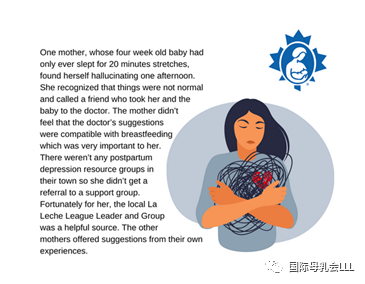
Many people are under the impression that breastfeeding is not recommended when treating mental health conditions with medication. This belief can make some mothers reluctant to consider medication as a treatment option. If you want to continue breastfeeding, let your healthcare professional know that you want a medication that is compatible with breastfeeding. If the suggested medication is not compatible with breastfeeding, you can ask for a different one.
Other treatments include:
·Increased consumption of long-chain fatty acids (omega 3s)
·Exercise
·SAMe (S-adenosyl-L-methionine) It is a compound found naturally in the body. A synthetic version may be available as a dietetic supplement.
·Cognitive-Behavioural Therapy (group or individual).
Most of the above treatments reduce inflammation in the body. The New Hampshire Breastfeeding Task Force’s document “ABreastfeeding-Friendly Approach to Depression in New Mothers” http://www.uppitysciencechick.com/ppd_curric_final_2009.pdf is an excellent resource for parents and professionals who want to look at all the options for treating PPD including drug therapy. See this PPD resource webpage for more resources.http://www.uppitysciencechick.com/postpartum-depression.html
Successful breastfeeding can be protective against developing these conditions. It can also be a helpful coping strategy. A combination of better latching technique and learning how to nurse lying down can help overcome difficulties.
Some women find that stopping breastfeeding improves their depression while others find that it worsens their depression. The decision to breastfeed or not is entirely up to you.
If you suspect that you or someone you love has PPD, PPA or postpartum PTSD, it is important to contact a healthcare provider. A La Leche League Leader can provide helpful support and information. If you think any of your mental health symptoms are related to a difficult birth experience see Moving Forward After a Traumatic or Difficult Birth Experience for more information.



参考资源
Resources:
Abramowitz, Jonathan. (2023). What are Postpartum and Perinatal OCD? International OCD Foundation.
Ali, E. Women’s experiences with postpartum anxiety disorders: A narrative literature review. International Journal of Women’s Health, 2018; 10: 237-249. DOI: 10.2147/IJWH.S158621
Balan, I., Patterson, R., Boero, G., Krohn, H., O’Buckley, T.K., Meltzer-Brody, S., Morrow, A.L. (2023). Brexanolone therapeutics in post-partum depression involves inhibition of systemic inflammatory pathways. eBioMedicine, (89).
Bass, P. F.; & Bauer, N. S. Parental postpartum depression: More than “baby blues”. Contemporary Pediatrics, Sept. 2018; 35(9): 35-38. (accessed 8 October 2022).
Bränn, E., Fransson, E., White, R. A., Papadopoulos, F. C., Edvinsson, Å., Kamali-Moghaddam, M., Cunningham, J. L., Sundström-Poromaa, I., & Skalkidou, A. (2020). Inflammatory markers in women with postpartum depressive symptoms. Journal of neuroscience research, 98(7), 1309–1321.
Fairbrother N, Collardeau F, Albert AYK, et al. (2021). High prevalence and incidence of obsessive-compulsive disorder among women across pregnancy and the postpartum. J Clin Psychiatry.
Kendall-Tackett, K., Cong, Z., & Hale, T. W. (2011). The effect of feeding method on sleep duration, maternal well-being, and postpartum depression. Clinical Lactation, 2(2), 22-26.
Nierengarten, M. B. Why screen new fathers for postpartum depression? Contemporary Pediatrics Journal, 2018; 35(9) September 2018. (accessed 8 May 2022).
Sawyer K. M. (2021). The role of inflammation in the pathogenesis of perinatal depression and offspring outcomes. Brain, behavior, & immunity – health, 18, 100390.
Srimoragot, M., Hershberger, P. E., Park, C., Hernandez, T. L., & Izci Balserak, B. (2023). Infant feeding type and maternal sleep during the postpartum period: a systematic review and meta-analysis. Journal of sleep research, 32(2), e13625.
2023年更新

END
译者 | Lynn
审阅 | 传艳、Marien、笑仪、Victoria
编辑 | 李热爱


更多阅读资料,
欢迎大家访问“国际母乳会LLL”官网:
https://www.muruhui.org/
分享
收藏
点赞
在看

本篇文章来源于微信公众号: 国际母乳会LLL
